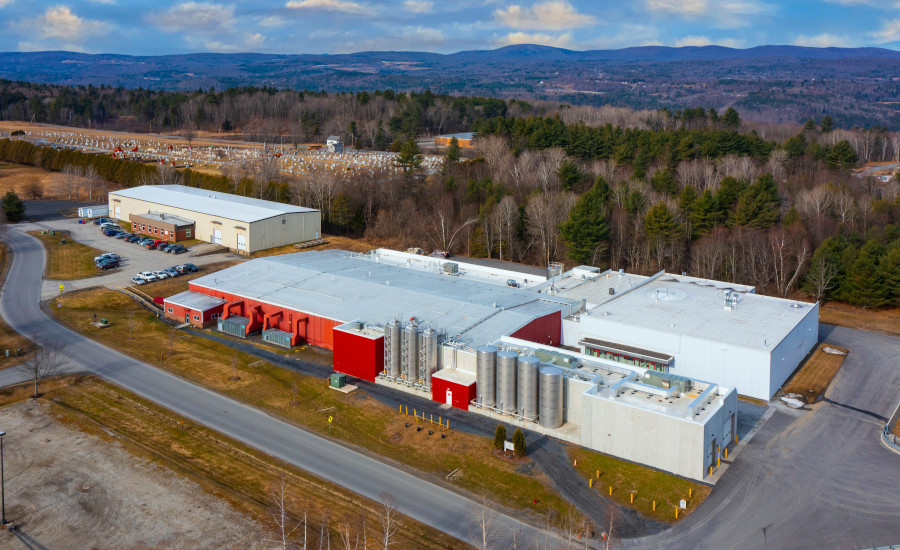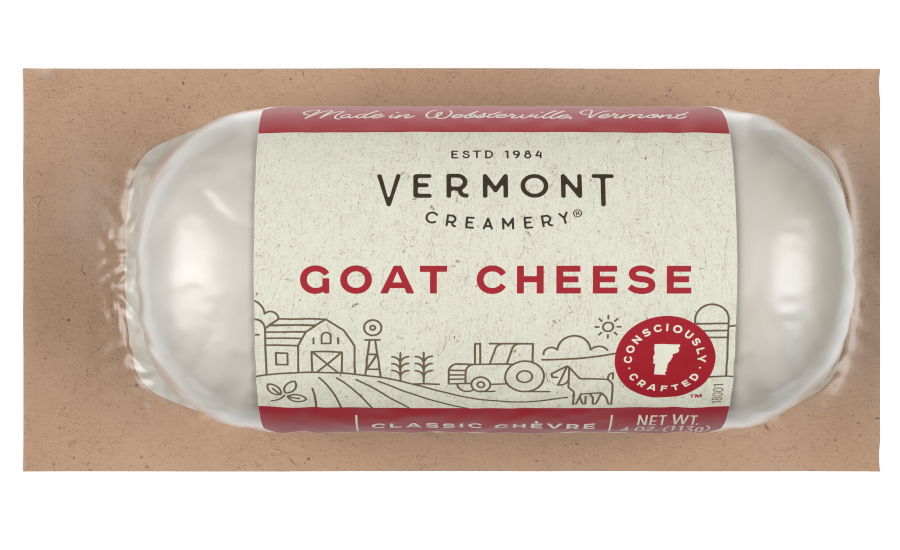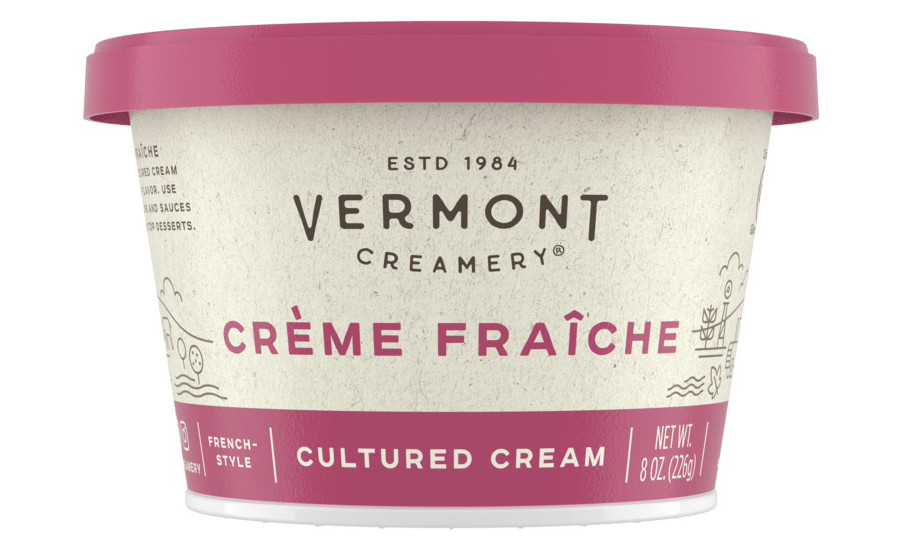Almost 40 years ago, back in 1984, Ronald Reagan crushed Walter Mondale in the U.S. presidential election; Alex Trebek began his long run as the host of “Jeopardy!;” and the Chicago White Sox and Milwaukee Brewers played the longest game in Major League Baseball history — 8 hours and 6 minutes spread across two days (the Brewers ultimately won).
That same year — with considerably less fanfare — Allison Hooper and Bob Reese founded Vermont Creamery. According to the Websterville, Vt.-based company, Reese had been charged by his employer, the Vermont Department of Agriculture, with organizing a dinner showcasing Vermont-made products. A French chef for the event wanted fresh goat cheese, so Reese ultimately turned to Hooper, who was employed by a local dairy lab but had learned how to make goat cheese during an internship on a French farm.
Hooper agreed to make the cheese, and it was “a hit” among the dinner party guests, Vermont Creamery notes. That night, Hooper and Reese partnered to launch what would become Vermont Creamery, a producer of fresh goat cheese.
Little by little, the company expanded, adding aged goat cheese and cow’s milk-based offerings (fresh and aged cheese, cultured butter, and culinary creams) to its repertoire.
A purpose-driven culture
Hooper and Reese retired in 2017. That same year, Arden Hills, Minn.-headquartered Land O’Lakes Inc. acquired Vermont Creamery. In a press release announcing the acquisition, Land O’Lakes’ Beth Ford — then group executive vice president and chief operating officer, and now CEO — explained why the acquisition made sense.
"Vermont Creamery's heritage mirrors our own here at Land O'Lakes — a company founded by people who care about bringing the highest quality products from farm to fork," she said. "We are excited about the culture of product innovation they have built, in addition to the category itself and the opportunities for even more expansion."
Since the acquisition, Vermont Creamery has, indeed, expanded operations. On the plant side, the dairy processor made investments in the intake, culturing and utilities systems, notes Rick Bart, director of operations, building a sophisticated butter manufacturing operation. The company also increased its warehousing and refrigerated storage facility to meet increasing customer demand. (See the Inside the Plant article.)
However, Vermont Creamery remains an independently operated subsidiary of Land O’Lakes, allowing the company to retain its unique culture.
“Culture is not only in our product, but in our business,” explains Adeline Druart, who joined Vermont Creamery in 2002 and has served as its president since 2015. In addition, she is vice president in Land O’Lakes’ Dairy Foods division.
“We build a strong and intentional culture for our people — our team of passionate and dedicated employees,” she adds. “We call ourselves ‘bettermakers’ because we strive to create a business where each employee has impact to make the world a better place.”

- Photo by Vito Palmisano.
As a purpose-driven business, Vermont Creamery relies on its Sustainable Business Strategy to guide the company, notes Eliza Leeper, mission manager.
“Our strategy is broken into four pillars for earth (environment), hands (people), supplies (supply chain) and roots (community),” she says. “Using business for good is part of who we have always been since we were founded in 1984 — it’s not a reaction to a trend.”
In 2014, Vermont Creamery also attained B Corporation (B Corp) certification. The certification “is a designation that a business is meeting high standards of verified performance, accountability and transparency on factors from employee benefits and charitable giving to supply chain practices and input materials,” according to certifying body B Lab.
“Our B Corp certification requires an audit every three years, ensuring we continue to commit ourselves to increasingly rigorous standards for environmental, social, workforce, and governance,” Leeper says.
Unique, ‘consciously crafted’ products
Producing exceptional, “consciously crafted” dairy products also is a key part of Vermont Creamery’s culture. The care Vermont Creamery takes in crafting its products sets it apart — as does the company’s status as one of pioneers within the U.S. artisan cheese space.
“Product quality and taste are paramount,” Druart says. “We are obsessed with ensuring our products are the best quality experience in the market.”
That obsession has netted a boatload of awards for Vermont Creamery’s products over the years. Most recently, the company took home three awards in the 2022 World Championship Cheese Contest in Madison, Wis. Its Madagascar Vanilla crème fraîche won Best in Class in the "Open Class: Soft Cheeses, Flavored" category, while its Cremont cheese received third place in the "Surface Ripened Mixed Milk Cheese" category. And the company’s Clover Blossom Honey fresh goat cheese took home third place in the "Soft Goat's Milk Cheeses, Flavored with Sweet Condiments" category.

- Photo by Vito Palmisano.
Vermont Creamery puts much time and thought into sourcing ingredients that will differentiate its cheese in terms of taste and appearance, Druart notes. It also invests in processes that — while adding time and complexity instead of taking shortcuts — result in richer flavor and higher quality.
For instance, it cultures its cream for 20-plus hours to optimize the diacetyl content in its cultured butter, resulting in a rich flavor with notes of hazelnut and butter. As Druart explains, Vermont Creamery was the first company to produce the product in the United States, supplying it first to high-end chefs and expanding its availability three years ago to the retail grocery channel.
“The product offers a superior taste along with higher fat,” she says, “and once consumers try our butter, they continue to buy it.”
Vermont Creamery’s goat cheeses are unique among soft-ripened, American-made cheeses, she adds. Delicate and exhibiting a wrinkly rind, the cheeses have a softer texture than imported goat cheeses. They also have a unique taste.
“We also have a line of geotricum cheeses where the rind quality is defined by the number and complexity of wrinkles,” Druart says. “In every line of products, we have carefully crafted the process to deliver the best taste.”
Yet another thing that sets Vermont Creamery apart is its status as a Vermont-based company. The dairy processor operates in a state that is recognized across the country for not only making some of the finest specialty food, but also being a home to “purpose-driven” companies, Druart notes.
“Being made in Vermont is very important to us, and we describe our products as being made ‘the Vermont way,’ including uncompromisingly high standards, taking the time to do things right and caring for our local communities and farms,” she says. “We say our dairy tastes better because it’s made better, and it’s true.”
Building on existing SKUs
Today, Vermont Creamery’s products are sold at retail grocers nationally, says Kate Paine, director of marketing. Products include seven varieties of fresh goat cheese logs, fresh goat cheese crumble, five different aged cheeses, six varieties of culinary cream, and both salted and unsalted cultured butter.
“We are a national brand, with our primary focus being retail stores, playing as a premium and superpremium brand in both the specialty set and dairy case,” she says. “We also have a foodservice portfolio with a focus on elevated fast-casual dining and white table-top, where quality, taste and clean sourcing are differentiators.”
New product development continues to be a focus for Vermont Creamery, too. The company plans to introduce three new goat cheese flavors this year, Paine says. (Although the company’s whole specialty portfolio is growing at a rate exceeding the categories, its fresh goat cheese — the No. 1 brand of goat cheese in the United States — has seen particularly strong recent growth.)

- Photo courtesy of Vermont Creamery.
“We do have a formal process with innovation gates and a long-range pipeline; yet much of that is formalizing a roadmap that the team has built by intuition and validated by reviewing category data and trends,” she explains. “We have a tight-knit cross-functional team, with core members from marketing and R&D and cross-functional members from sales, operations, packaging, supplier quality, and more brought in at different points in the process.”
Eye on responsible growth
Vermont Creamery has expanded significantly in its 38 years of operation, but the company aims to double its business in the next five years in terms of revenue and impact, Druart says.
“We are on a growth trajectory and have an incredible team, product portfolio, customer relationships, and authentic brand that consumers love as our engine.”


- Photo courtesy of Vermont Creamery.
That anticipated growth will include expansion in a number of premium dairy categories found in the dairy case and the specialty set. But the route will be one of responsible growth, Druart says.
“We expand based on reaching velocity hurdles prior to expanding distribution, ensuring we’re driving a critical level of turns and keeping a healthy business within our current customer base before expanding,” she explains. “While there is validated demand for our products and more innovation from Vermont Creamery, growth has an initial cost, and we take this on responsibly to ensure steady yet aggressive growth.”
To expand sales of its products, Vermont Creamery boasts a “full-funnel marketing plan” that aims to build awareness for both the brand and the products, “engage consumers with relevant and inspirational content,” spur trial through sales incentives and signage at shelf, and build loyalty post-purchase, Paine notes. The company’s marketing programs rely on “a creative voice and simple, bold imagery” to communicate the artisan aspects of the products. The program also educates consumers about responsible food systems.
“Our marketing is a healthy mix of brand-building activities and trial-driving sales activation,” she points out.
Social media plays a role in Vermont Creamery’s marketing efforts, too, with the company getting the most engagement on Facebook, Instagram, and Pinterest, Druart says. And prior to the COVID-19 pandemic, the company was active “on the event circuit” — with live events returning, the company is now determining which events are worth an investment.
Growth-driven leadership
Vermont Creamery is well situated to attain its near-term growth goals. However, the dairy processor does face some challenges along the way.
“One of our biggest challenges continues to be the need for [an adequate] manufacturing workforce — and the need for manufacturing to refine itself to be a lot more flexible,” Druart says.
Other challenges spell opportunity.
“We have an opportunity to reduce our climate impact by leveraging our farmland, reducing our food waste with the help of our partner biodigester and continuing to use sustainable packaging,” Leeper points out.
Druart says the company must also continue to “diversify dairy farming” by providing opportunities for farmers such as adding or transitioning to goat farming and potentially changing their business model.
“We need to continue to educate consumers, help them sort through claims and ‘authentic versus not.’ With fragmentation in categories, the importance of investing in the brand and differentiated portfolio, customer relationships, and innovation is so important,” she stresses. “There’s also digital acceleration and consumers’ purchase changes — ordering via ecommerce, click and collect, meal kits, D2C, etc. We have evolved our omnichannel strategy and will need to continue to shift to accommodate changes in consumer patterns.”

- Photo courtesy of Vermont Creamery.
Thankfully, Vermont Creamery has a strong leadership team in place to tackle these and other challenges. That team is diverse, Druart says, comprising four women and four men with experience ranging from stints at small business operations to positions at large consumer packaged goods companies. Longtime employees work alongside newer employees on the team.
“Our team is smart, humble, hungry, and very passionate about the business, our ‘bettermakers’ and our mission impact,” she adds. “All of them are growth- and purpose-driven, which is important as we continue to expand our brand in the marketplace and alongside all aspects of our business ecosystem.”



.jpg?height=200&t=1630591584&width=200)